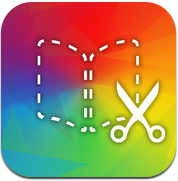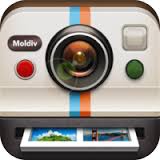 A great app that gets your students talking and listening. Really easy to use, you add a picture from your camera roll or you can take a picture directly from the ipad camera. Once the picture is added, you trace sections of your photos. After each trace, you press the record button and describe or talk about that part of the picture. You can have up to ten traces and recordings. The app is intuitive and very simple to use. I like the fact that I can give my students authentic pictures on a certain topic, and then students using the target vocabulary need to talk about the image. Once completed students can share their talking picture via email or through a Dropbox app. I believe the app is $0.99, however I obtained it for free as it currently has a price drop.
A great app that gets your students talking and listening. Really easy to use, you add a picture from your camera roll or you can take a picture directly from the ipad camera. Once the picture is added, you trace sections of your photos. After each trace, you press the record button and describe or talk about that part of the picture. You can have up to ten traces and recordings. The app is intuitive and very simple to use. I like the fact that I can give my students authentic pictures on a certain topic, and then students using the target vocabulary need to talk about the image. Once completed students can share their talking picture via email or through a Dropbox app. I believe the app is $0.99, however I obtained it for free as it currently has a price drop.
Talking Pictures
June 16, 2013 — JoyceComicBook!
June 15, 2013 — Joyce ComicBook is a very simple and easy to use app which allows you to create a comic strip in a matter of minutes with minimal effort.
ComicBook is a very simple and easy to use app which allows you to create a comic strip in a matter of minutes with minimal effort.
Starting with one of 30 different layout templates, ComicBook lets you import images from your camera roll or take photos from the ipad camera to drop into each panel. You can rotate and zoom each picture to get the right fit in the frame, and apply a wide range of visual effects. Once you have added your images you can then add text, word bubbles, and stamps, all of which can be individually customised. After dropping a text box or word bubble anywhere on the screen, you can easily move it around, adjust the tail direction, and input dialogue. The easy to use and friendly interface makes undoing mistakes an uncomplicated process, and if you need, there is an in-depth help menu explains all of the features in detail. Once you have created your comics you can save it to your camera roll, share it via email or a Dropbox app.
At a cost of $1.99 this app is excellent value. I was lucky enough to get mine for free as the makers of the app had dropped the price to $0.00 during May, so it pays to keep a look out for apps gone free.
Bitsboard
June 14, 2013 — Joyce I am so excited about this app, as it has huge potential in our languages classroom. As a teacher, you create sets of flashcards that can be totally customised for your student needs. Flash cards incorporate images, text and audio. However, before I turn you off by waxing lyrical about a flash card app, let me be quite clear this is not your average flash card app, it is much more than that. Once you have created your set, called a board, you can then share your set. Students can then download onto their iPad and play interactive word games. Games include word match, picture match, and true and false questions. Students get instant feedback on how they went. Best of all the app is free.
I am so excited about this app, as it has huge potential in our languages classroom. As a teacher, you create sets of flashcards that can be totally customised for your student needs. Flash cards incorporate images, text and audio. However, before I turn you off by waxing lyrical about a flash card app, let me be quite clear this is not your average flash card app, it is much more than that. Once you have created your set, called a board, you can then share your set. Students can then download onto their iPad and play interactive word games. Games include word match, picture match, and true and false questions. Students get instant feedback on how they went. Best of all the app is free.
Book Creator
June 14, 2013 — Joyce Book Creator allows you to create narrated books on your iPad. It allows anyone to create their own books using images, text, videos, and audio recordings. Each page in your book can include pictures and videos from your iPad’s camera roll. In addition to the pictures and videos you can include text. You are not limited to the amount of text you can add, providing it can fit on one page. If you would like to narrate your book, all you need to do is tap the record button to add your voice to each page of your book. You change change backgrounds, add front and back covers and create a very professional looking narrated book. Once you have created your book, you can open it in iBooks or send to Dropbox or another drop box type sharing app. (At my school we use eLocker). Whilst a little pricey at $5.49 I just love this app. My students find it very easy to use, when opening it for the first time; students knew intuitively what to do.
Book Creator allows you to create narrated books on your iPad. It allows anyone to create their own books using images, text, videos, and audio recordings. Each page in your book can include pictures and videos from your iPad’s camera roll. In addition to the pictures and videos you can include text. You are not limited to the amount of text you can add, providing it can fit on one page. If you would like to narrate your book, all you need to do is tap the record button to add your voice to each page of your book. You change change backgrounds, add front and back covers and create a very professional looking narrated book. Once you have created your book, you can open it in iBooks or send to Dropbox or another drop box type sharing app. (At my school we use eLocker). Whilst a little pricey at $5.49 I just love this app. My students find it very easy to use, when opening it for the first time; students knew intuitively what to do.
Moldiv
June 13, 2013 — Joyce There are many collage and poster apps, but I am really enjoying Moldiv. This app is extremely easy to use. You just tap on a frame (similar to a template) to select your photo layout and then tap on a section to add a photo. You can use the photos from your photo gallery or take a new one using the camera. Once you add in your photos, you can tweak the layout by adjusting the frame width and adding a background fills. For the creative amongst us you can add photo effects and decoration features such as stamps.
There are many collage and poster apps, but I am really enjoying Moldiv. This app is extremely easy to use. You just tap on a frame (similar to a template) to select your photo layout and then tap on a section to add a photo. You can use the photos from your photo gallery or take a new one using the camera. Once you add in your photos, you can tweak the layout by adjusting the frame width and adding a background fills. For the creative amongst us you can add photo effects and decoration features such as stamps.
Moldiv also allows you to add text. Text can also be manipulated to different fonts, effects and colours.
This is a must app and best of all, it is free.
Qrafter
June 12, 2013 — Joyce There are many QR code scanners and creators available. However, I really like this app because you can scan with your camera or if you have an existing QR code in your camera roll you are able to scan from your photo albums. I like to create QR code worksheets to do matching word or matching phrase activities. Students like scanning the codes, and I do not have to spend enormous amounts of time making class sets of cards. No more photocopying or laminating.
There are many QR code scanners and creators available. However, I really like this app because you can scan with your camera or if you have an existing QR code in your camera roll you are able to scan from your photo albums. I like to create QR code worksheets to do matching word or matching phrase activities. Students like scanning the codes, and I do not have to spend enormous amounts of time making class sets of cards. No more photocopying or laminating.
This app allows you to create QR codes as well, and the interface has a very user friendly design. However, I haven’t used this feature as I still prefer creating worksheets etc using my laptop.
Overall, this is an excellent app and best of all it is free.
Notability
June 11, 2013 — Joyce Notability is a really cool app that allows you to annotate PDFs. Teachers upload or email their PDF worksheets to students, and once received, students can open and annotate the PDF documents. Notability allows students to fill in the PDF document just as they would normally do using pencil and paper. So the question is: “why would you bother”? Well, the bonus is as teachers we no longer need to spend hours in front of the photocopier and students can no longer use the excuse that they never received the worksheet or they have lost the worksheet etc. So it is a win for everyone.
Notability is a really cool app that allows you to annotate PDFs. Teachers upload or email their PDF worksheets to students, and once received, students can open and annotate the PDF documents. Notability allows students to fill in the PDF document just as they would normally do using pencil and paper. So the question is: “why would you bother”? Well, the bonus is as teachers we no longer need to spend hours in front of the photocopier and students can no longer use the excuse that they never received the worksheet or they have lost the worksheet etc. So it is a win for everyone.
As well as using the app for PDF annotation, you can use the app to create notes, either handwritten or by using the ipad keyboard. You are also able to link audio recordings to your notes, insert photos, web images, drawings, etc and search for existing notes. So it is pretty much like using a workbook just with a lot more options.
At 0.99 cents, it is well worth its value.
Socrative
June 9, 2013 — Joyce There is nothing quite like real-time feedback to determine if students really got it!
There is nothing quite like real-time feedback to determine if students really got it!
Socrative, which runs on tablets, smartphones, and laptops, is an interesting app because it allows me to pose a question and have students respond in real time to my inquiry. I can assess on the fly and best of all, students can use their portable media to provide me with near instant feedback.
As well as this I can create quizzes which students can take in the form of a quiz or a game. Space Race game is really engaging and a lot of fun, students aren’t even aware they are doing a quiz.
There are two versions of Socrative—a student version and a teacher version. Upon logging in, students enter a room number. The teacher can then see how many students are in the room posing questions to the students or start a quiz or game.
For further information and detailed instructions on how to use Socrative open up my webinar that I recently conducted with MLTAV.
Move and Match
June 8, 2013 — Joyce This is an awesome app which I am using constantly in my classroom. You can create simple practice word games and picture and word matching games. You create the games, share with your students, and your students can do the activities by simply moving the words or pictures around to match them together.
This is an awesome app which I am using constantly in my classroom. You can create simple practice word games and picture and word matching games. You create the games, share with your students, and your students can do the activities by simply moving the words or pictures around to match them together.
You can create your own projects and customise them to fit your classes specific needs.
Some ways I have used this app is to create
- cloze activities
- dialogue activities
- word and picture match
The app does cost $1.99, which you need as a teacher, as this allows you to create or “make” projects and share your projects. However, students only need to download the free lite app. This app is limited in functionality, however, they can open your shared projects and to use.
About Me
June 8, 2013 — JoyceAfter completing my Postgraduate Diploma in languages (Indonesian), I changed my teaching direction to become an Indonesian language teacher. Previous to this I was teaching mainly ICT from Year 8 to Year 12. Now, I am teaching a combination of both these subjects, concentrating on teaching Indonesia to Years 7 – 9, and ICT at senior level. I have had the opportunity to study at the Universitas Islam Negeri in Malang East Java, as well as being a recipient of the Endeavour Language Teachers Fellowship enabling me to further study Indonesian for 3 weeks in Denpasar, Bali.
Last year, the school where I work introduced iPads to all Year 7 classes, and this year we have become a 1:1 iPad school for all year 7 to 9. It has been a challenging yet fun experience sourcing out appropriate apps, and how to use the apps to enhance my teaching and my student learning.
Each day, I hope to review a useful app that can be used in the languages classroom. I hope you find the reviews useful.
Joyce Tabone